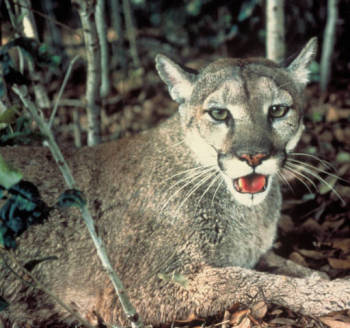Florida Panther
Category: Big Cats

Facts about Florida Panthers. "Scientific name for Florida panther is concolor coryi. Florida Panther is a regional population of the cougar, puma and mountain lion.
The Florida panther is endangered. There are estimated to be 150 to 200 Florida panthers in the wild. This is actually an increase from the 20 or so thought to be in the wild in the 1970s.
Habitat of Florida Panther
Florida panthers live in swamp forests and pine-lands. They will live in prairies, swamps and forests.
The Florida panther once lived throughout the Southeast. They used to range from Arkansas to South Carolina to Florida. Now the only breeding population is in Florida, sought of the Caloosahatchee River.
Many of the remaining Florida panthers live in the Everglades National Park, the Big Cypress National Preserve and Florida Panther National Wildlife Refuge. Young males have been seen outside of Florida, but females have not been seen outside of south Florida.
Behavior of Florida Panther
Florida panthers are solitary animals. They are most active between sunset and sunrise.
The average male panther needs around 200 square miles (520 square km) of territory, making it hard to set aside enough land to sustain a viable population. Females have smaller territories of around 75 square miles (195 square km). They feed on deer, raccoons, feral pigs, birds, rabbits, armadillos and other animals. They will eat reptiles.
Florida panthers are mostly quiet but can vocalize via purrs, growls, hisses, moans and chirps. The females yowl around mating time.
Gestation time is 90 days for this species. Their mating season is year-round, but it peaks in the winter and spring.
Florida panthers give birth to litters of one to four kittens. Kittens are born with spots that fade as they age. Rarely do all kittens survive. Kittens stay with the mother for up to two years. After that, both males and females become solitary.
Physical Characteristics of Florida Panther
The Florida panther has a tawny brown back and pale gray underside. They have black marks on the tips of their ears and tail. One of the few racial differences between Florida panthers and other panthers is that the Florida panther has a crooked tail, as well as a patch of fur on the back that looks like a cowlick.
Males can weigh up to 160 pounds (73 kg) and reach seven feet long. Females are smaller. They can live up to twelve years in the wild.
Threats to the Florida Panther Species
The greatest threat to the species is habitat destruction and fragmentation. Road kills and illegal hunting are another threat to the Florida panther. Nineteen panthers were killed by vehicles in 2012, up from the fifteen killed by cars in 2013.
The species was originally drive almost to extinction by hunting to protect people and livestock from predation.
Restoration Efforts for Florida Panther
The U.S. Fish and Wildlife Service tried to improve the genetic diversity of the population by adding eight females from Texas into Florida. This 1995 effort led to growth of the population from around 20 breeding animals to 120 and greater genetic diversity. Genetic diversity is considered important for preventing inbreeding depression (decreased health of inbred animals) and decreased fertility.
Trivia about Florida Panther
The Florida panther was selected as the Florida state animal in 1982.
The Florida panther was one of the first species added to the endangered species list, though it is not truly a separate species.

 Back To Category Big Cats
Back To Category Big Cats